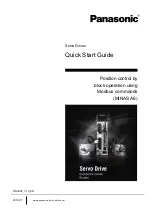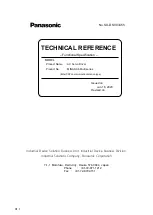
M2DC Series Hardware Manual
142
Rev. 1.1
2018/04
400-820-9661
9.3 Modbus/RTU Communication
There are two types of communication methods for Modbus, ASCII (American Standard Code for
information interchange), and RTU (Remote Terminal Unit). They are defined based on different bus
modulation and demodulation methods. For M2DC series servo drives, only Modbus/RTU is supported.
9.3.1 Data Encoding
Big-endian: The most significant byte (MSB) value is stored at the memory location with the lowest
address; the next byte value in significance is stored at the next memory location and so on. This is akin
to Left-to-Right reading in hexadecimal order.
For example: To store a 32bit data 0x12345678 into register addresses 40031 and 40032, with 0x1234
defined as MSB, and 0x5678 as LSB, in big-endian system:
Register 40031 = 0x1234
Register 40032 = 0x5678
When transferring 0x12345678, the first word will be 0x1234, and the second word will be 0x5678.
Little-endian: The most significant byte (MSB) value is stored at the memory location with the highest
address; the next byte value in significance is stored at the next memory location and so on. This is akin
to Left-to-Right reading in hexadecimal order.
For example: To store a 32bit data 0x12345678 into register addresses 40031 and 40032, with 0x5678
defined as MSB, and 0x1234 as LSB, in little-endian system:
Register 40031 = 0x5678
Register 40032 = 0x1234
When transferring 0x12345678, the first word will be 0x5678, and the second word will be 0x1234.
The M2 drive parameter P-75 (PR) defines the data transfer type:
P-75 (PR) = 5 represents big-endian
P-75 (PR) = 133 represents little-endian
9.3.2 Communication Address
In the network system, each drive requires a unique drive address. Only the drive with the matching
address will respond to the host command. In a Modbus network, address “0” is the broadcast address. It
cannot be used for an individual drive’s address. ModbusRTU/ASCII can set the drive address from 1 to
31.
9.3.3 Communication Baud Rate And Framing
M2DC series servo drives have fixed communication data framing: 8 data bits, one stop bit, no pairty.
The drive parameter P-77 (BR) defines the communication baud rate.
In serial communication, the change of baudrate will NOT take effect immediately, it will ONLY take effect
at the next power up of the drive.
1: 9600bps
2: 19200bps
3: 38400bps
4: 57600bps
5: 115200bps
















































